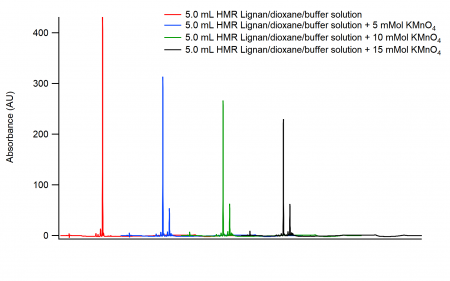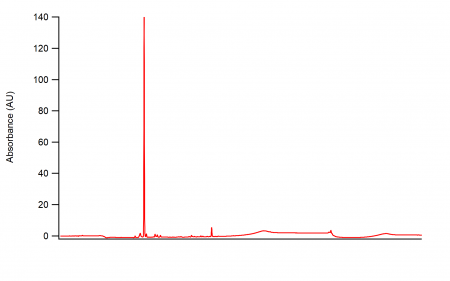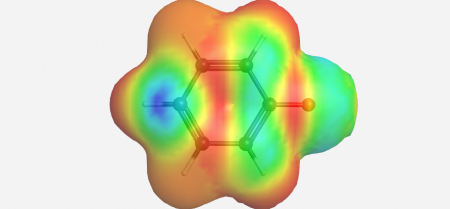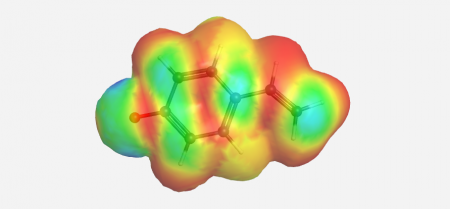Lignan Project
The following document was completed by Taylor Coffman in Spring of 2021 in partial fulfillment of her requirements for a Bachelor's Degree of Science in Biochemistry, Monmouth College, Monmouth, Il 61462. The research was done under the supervision of Bradley E. Sturgeon.
Abstract
Lignin monomers can couple to form large organic polymers (lignin) or dimerize to form a lignan. Lignans are biologically active compounds of interest in medical research, although lignans are not readily available and are expensive. An easily obtained product claiming to contain the lignan, hydroxymatairesinol, is available for purchase from Amazon.com. This project will outline the purification, concentration, and eventual characterization of this material to allow for other medical-related lignan research projects. HPLC analysis and computational techniques (Gaussian and WINSIM) will be presented to further understanding of the oxidative coupling of these monomers with the hope of providing insights that could lead to the commercial production of various lignans.
Introduction
Lignin is an abundant, complex organic polymer that acts as one of the principle components of plants. Lignin plays a role in the structure of plant cell walls, works to move water through the plant to critical areas and helps to prevent water evaporation. [1] Lignins account for a large percentage of overall plant mass, at around 20-25%. [2] We know that lignin does not act alone in it’s structural duties, commonly forming complexes with polymeric carbohydrates. [3] Difficulty in isolating lignin from these lignin-carbohydrate complexes means that synthetic lignins are commonly used for research purposes. The basic monomers that make up the lignin polymer are p-coumaryl alcohol, coniferyl alcohol, and sinapyl alcohol. These three monomers are phenylpropane units that differ in their substitutions at the 3 and 5 positions. [4] In the case of lignin nomenclature, the side chain attachment to the aromatic ring is considered position C-1 and the phenol group considered to be position C-4. These monomeric alcohols undergo oxidative coupling with each other and with a growing polymer end unit. [5] This oxidation process results in radicals delocalized at positions C-1, C-3, C-5, C-β, and O-4. [6] The most frequently formed bonds are β-O-4 bonds. [7]
The coupling of two lignin monomers, usually at their β carbons, results in lignan, a nonstructural component of plants that play a role in plant defense.[8] These lignans show important biological activity that the lignin polymer does not.[9] One interesting medical application of lignan is found in its interactions with breast cancer. It has been shown that both flaxseed and sesame seed lignans and their metabolites have the potential to act as competitive inhibitors of estrogen and prevent the binding of estrogen to estrogen receptors on breast cancer tumors.[10][11]. These effects are possible on the basis that many lignans share structural features with the human estrogen estradiol, including hydrophobic benzene rings and alcohol groups that are capable of interaction with the binding site of the estrogen receptor.[12][13] Lignan also displays antioxidant properties, showing the ability to scavenge hydroxyl radicals.[14][15] Lignan’s medical applications make it an interesting topic for further study, but an issue lies within the commercial availability of lignan. Lignan itself is not commercially available except as an analytical standard, and analytical standards can range upwards of $300 USD for 10 mg of product. For an undergraduate research lab, this presents serious problems in terms of budget and funding. In order to study the chemistry of lignans, we need a way to isolate and purify lignans in a cost effective manner.
Experimental Methods
Materials
Lignans for Life Hydroxymatairesinol (HMR) Lignan was obtained from Amazon.com (Seattle, WA, USA) while ethanol, 1,4-Dioxane, pH 5 Phosphate-Citrate Buffer, and KMnO4 were obtained from Sigma Aldrich (St. Louis, MO, USA).
Lignan Purification
Solutions of 1 HMR Lignan capsule (0.169 g), 5 HMR Lignan capsules (0.785 g), and 100.0 mL of EtOH and 10 HMR Lignan capsules (1.629 g) and 100.0 mL of EtOH were prepared. These solutions were filtered and analyzed using an Agilent 1100 Series HPLC with a C18 column (4.16 x 100 mm length and 3.5 μm particle size) at absorbance wavelength of 270 nm and temperature of 28°C using an acetonitrile (ACN) and 0.1% TFA gradient for 30 minutes. The first 15 minutes were run at 100% 0.1% TFA, 15-25 minutes at 100% ACN, and 25-30 minutes at 100% 0.1% TFA.
Lignan Concentration
Solutions of 2 HMR Lignan capsules + 20.0 mL of 1,4-Dioxane and 4 HMR Lignan capsules + 40.0 mL of 1,4-Dioxane were prepared. These solutions were filtered and analyzed using an Agilent 1100 Series HPLC with a C18 column (4.16 x 100 mm length and 3.5 μm particle size) at absorbance wavelength of 270 nm and temperature of 28°C using an acetonitrile (ACN) and 0.1% TFA gradient for 30 minutes. The first 15 minutes were run at 100% 0.1% TFA, 15-25 minutes at 100% ACN, and 25-30 minutes at 100% 0.1% TFA.
The solution of 4 HMR Lignan capsules in 40 mL of 1,4-Dioxane was used to fill ten 1.5 mL Eppendorf tubes with 1.0 mL of solution. These Eppendorf tubes were placed in a Savant Speedvac SC110 Concentrator (Holbrook, NY, USA) and spun overnight to remove the solvent. The pelleted solute in each Eppendorf tube was then resolubilized using 1.0 mL of EtOH.
The Lignan concentrate (10 μL) in 1.0 mL of H2O was ran on an Agilent 1100 Series HPLC with a C18 column (4.16 x 100 mm length and 3.5 μm particle size) at absorbance wavelength of 270 nm and temperature of 28°C using an acetonitrile (ACN) and 0.1% TFA gradient for 30 minutes. The first 15 minutes were run at 100% 0.1% TFA, 15-25 minutes at 100% ACN, and 25-30 minutes at 100% 0.1% TFA.
Lignan Degradation
A solution of 10 HMR Lignan capsules in 100.0 mL of 1,4-Dioxane solution was prepared. This HMR Lignan/dioxane solution (25.0 mL) was added to 25.0 mL of pH 5 Phosphate-Citrate buffer.
A solution of 0.0395 g of KMnO4 and 1000 μL H2O was prepared.
The following solutions were analyzed on an Agilent 1100 HPLC with a C18 column (4.16 x 100 mm length and 3.5 μm particle size) at absorbance wavelength of 270 nm and temperature of 28°C using an acetonitrile (ACN) and 0.1% TFA gradient for 30 minutes. The first 15 minutes were run at 100% 0.1% TFA, 15-25 minutes at 100% ACN, and 25-30 minutes at 100% 0.1% TFA:
- 5.0 mL of the HMR Lignan/dioxane/buffer solution
- 5.0 mL of the HMR Lignan/dioxane/buffer solution + 5 mMol KMnO4
- 5.0 mL of the HMR Lignan/dioxane/buffer solution + 10 mMol KMnO4
- 5.0 mL of the HMR Lignan/dioxane/buffer solution + 15 mMol KMnO4
Electron Density Analysis of Lignin Monomer-Like Molecules
Geometry Optimization and Molecular Orbital calculations were performed on Phenoxyl and 5-Vinylphenoxyl in WebMO using the B3YLP theory, accurate: 6-311+G(2d,p) basis set, and a density=current keyword. Hyperfine coupling constants were entered into WINSIM in order to predict EPR Spectra.
Results and Discussion
Lignan Purification
Lignan purification trials indicated that HMR Lignans already came in a relatively pure form. In Figure 1., each subsequent peak indicates that as the amount of solute increased per trial, the amount of "lignan" in the solution also increased, which indicates that the capsules are homogenous in terms of amount of material. There is also a low amount of noise, indicating that whatever material is in these capsules, the material is for mostly pure with little pollution. Further tests should be done to characterize this material and confirm that it is truly hydroxymatairesinol and to confirm that the manufacturers claims are accurate.
Lignan Concentration
In order to get a workable amount of lignan from these capsules, concentration was performed in order to produce enough product so that further studies can be performed using this material. This could include characterization of the product and assays to determine if the material has antibiotic properties. Figure 2. indicates that there is a relatively consistent amount of material in these capsules and that there is some level of quality control of the overall product. This is important while performing concentration of the product so that a reliable amount of concentrate can be obtained. Figure 3. indicates that that material was successfully concentrated. Done at a larger scale, this portion of the overall project will be helpful towards gaining a tangible amount of material for further testing.
Lignan Degradation

In order to better understand the coupling of lignin monomers, degradation of lignan can be performed. Understanding the modes of the degradation of lignan can help understand the pattern in which lignin monomers couple. In Figure 4., we see that with increased amount of KMnO4, the amount of starting material decreases and the amount of products increases, indicating that successful degradation of this material was completed. Further analysis of these degradation products, for example through characterization of theese products, may allow better insight into the coupling of lignin monomers.
Electron Density Analysis of Lignin Monomer-Like Molecules
Table 1. Hyperfine coupling constants of Phenoxy and 4-Vinylphenoxy
| Phenoxyl | 4-Vinylphenoxyl |
|---|---|
| 2.65 | 2.33 |
| 2.65 | 2.50 |
| 6.86 | 2.70 |
| 6.68 | 5.35 |
| 9.12 | 6.24 |
| 6.72 | |
| 7.17 |
Figures 5-9. illustrate the structure, radical frontier density, and predicted ESR spectrum of two lignin monomer-like structures, Phenoxyl and 4-Vinylphenoxyl. Table 1. lists the hyperfine coupling constants used to construct the predicted ESR spectrum. The radical density of these structures (blue/green areas) allows us to predict that the radical would spend the majority of it's time in the ortho and para positions. While Phenoxyl and 4-Vinylphenoxyl are not lignin monomers, there structures are similar to those of the three lignin monomers (p-coumaryl alcohol, coniferyl alcohol, and sinapyl alcohol) and can give us insight into how these monomers radicalize and couple to form both lignan and lignin. If these reactions are better understood, lignan itself could be synthetically produced for use in various medical applications.
Conclusion
In terms of studying lignin, lignan, and lignin monomers in an undergraduate laboratory, cost and availability of materials must be strongly considered. A cheap source of a potential lignan, hydroxymatairesinol, can be obtained from Amazon.com in the form of a human supplement. Purification and concentration of the material may lead to a cheap source of HMR lignan that can be utilized in undergraduate laboratories for potential projects relating to the coupling of lignin monomers or the degradation of lignin. As lignan itself is known to have biological activity, accessible amount of HMR lignan can be utilized in a lab to run different biological tests for antibacterial, antimicrobial, and anticancer activity. There is a lot of work to be done in the understanding of lignin monomer coupling, which is highly randomized and not well understood. Because as of now these studies are not cost effective for an undergraduate lab, being able to access cheap lignan will improve the viability of this research. This research project has indicated that obtainment of cheap hydroxymatairesinol from this readily available source is not only possible, but that this method may be used towards purification of other lignans from products marketed as supplements.
References
- ↑ Dimmel, D. (2010). Overview. Lignin and Lignans Advances in Chemistry. Taylor & Francis Group.
- ↑ Lewis, N. G., Davin, L. B., & Sarkanen, S. (1998) Lignan and Lignan Biosynthesis: Distinctions and Reconciliations. American Chemical Society Symposium Series, 1-27.
- ↑ Dimmel, D. (2010). Overview. Lignin and Lignans Advances in Chemistry. Taylor & Francis Group.
- ↑ Dimmel, D. (2010). Overview. Lignin and Lignans Advances in Chemistry. Taylor & Francis Group.
- ↑ Dimmel, D. (2010). Overview. Lignin and Lignans Advances in Chemistry. Taylor & Francis Group.
- ↑ Dimmel, D. (2010). Overview. Lignin and Lignans Advances in Chemistry. Taylor & Francis Group.
- ↑ Dimmel, D. (2010). Overview. Lignin and Lignans Advances in Chemistry. Taylor & Francis Group.
- ↑ Lewis, N. G., Davin, L. B., & Sarkanen, S. (1998) Lignan and Lignan Biosynthesis: Distinctions and Reconciliations. American Chemical Society Symposium Series, 1-27.
- ↑ Lewis, N. G., Davin, L. B., & Sarkanen, S. (1998) Lignan and Lignan Biosynthesis: Distinctions and Reconciliations. American Chemical Society Symposium Series, 1-27.
- ↑ Rodríguez-García et al. (2019). Naturally Lignan-Rich Foods: A Dietary Tool for Health Promotion. Molecules, 24(917), 1-25.
- ↑ Pianjing, P., Thiantanawat, A., Rangkadilok, N., Watcharasit, P., Mahidol, C., Satayavivad, J. (2001) Journal of Agricultural and Food Chemistry, 59, 212–221
- ↑ Pianjing, P., Thiantanawat, A., Rangkadilok, N., Watcharasit, P., Mahidol, C., Satayavivad, J. (2001) Journal of Agricultural and Food Chemistry, 59, 212–221
- ↑ Brzozowski, A. M., Pike, A. C., Dauter, Z., Hubbard, R. E., Bonn, T., Engström, O., Ohman, L., Greene, G. L., Gustafsson, J. A., Carlquist, M. (1997). Molecular basis of agonism and antagonism in the oestrogen receptor. Nature 389 (6652), 753–758.
- ↑ Rodríguez-García et al. (2019). Naturally Lignan-Rich Foods: A Dietary Tool for Health Promotion. Molecules, 24(917), 1-25.
- ↑ Touré A., Xu X. (2010). Flaxseed Lignans: Source, Biosynthesis, Metabolism, Antioxidant Activity, Bio-Active Components, Health Benefits. Comprehensive Reviews in Food Science and Food Safety 9:261–269.











